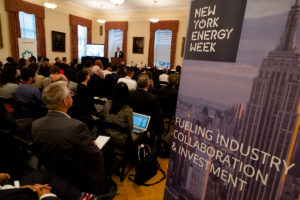“We should look at the whole neighborhood as one. If we stop thinking of zero-carbon buildings but look at entire neighborhoods or event cities to make them carbon-neutral – it will be much cheaper.” – Lars Osterfeld Riemann
Yesterday, NYEW 2016 featured two panels on a related topic – Energy-Supply Future for Buildings, focused on distributed generation and the Future of Demand-Side Management, with energy efficiency among the core topics.
According to the panelists, utility customers had become more energy savvy in the recent decade. “The customers want a hat trick of environmental, efficient, and economic energy,” said Kristin Barbato, Vice President of Customer Energy Solutions, New York Power Authority.
The growth of distributed generation – including combined heat and power and solar – is transforming both the customers’ needs from the grid from a one-way to a two-way system as well as the planning process for utilities, “breaking up a process that has been a place for a long time,” emphasized Andre Wellington, Senior Engineer and Technical Project Manager, ConEdison.

Panelists at the Energy-Supple Future for Buildings Breakfast
The experts on the evening panel also highlighted the rate of change in energy efficiency in buildings. According to Bo Nørregaard Jørgensen, Head of Center for Energy Informatics, University of Southern Denmark, energy efficiency in buildings was crucial for reducing overall energy consumption, as buildings in cities like New York account for over 90% of total electricity consumption.
Energy codes have been evolving steadily, the panelists pointed out. However, one of the issues that Lars Ostenfeld Riemann, Global Director, Buildings, Ramboll, mentioned was the handover of the new building. “There is a big loss of knowledge if the operator does not understand how the building is meant to function,” he said and stressed the need for training and instruction – “fine-tuning the machine” – to ensure that the energy-efficient design works as planned in operation.

